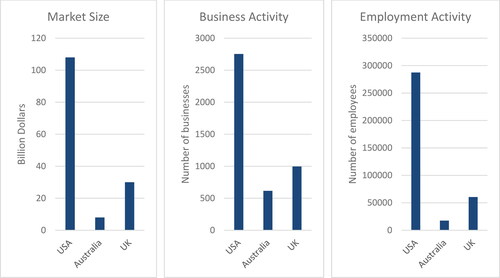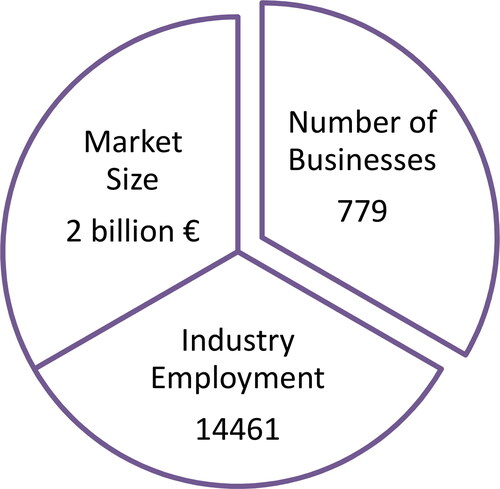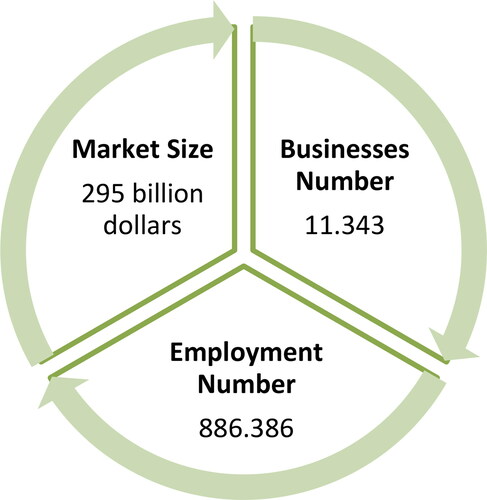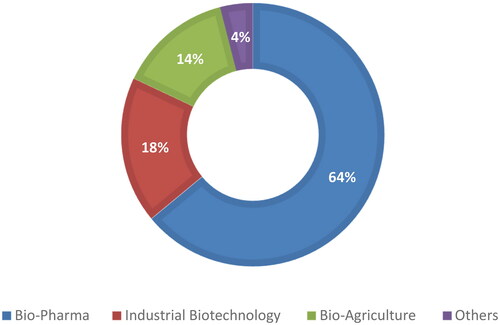Abstract
Biotechnology is an innovative, interdisciplinary field that impacts many different sectors, including agriculture, veterinary, medicine, pharmaceutical and fine chemicals production. It is emerging as one of the leading technologies for the transition towards carbon-free society and for solving critical societal challenges comprising health protection, food and energy supply, and environmental protection. Professional networks such as EBTNA (European Biotechnology Thematic Network Association) are important to disseminate knowledge and raise awareness of biotechnology as one of the key enabling technologies for sustainable production.
Categories of biotechnology industries in the world
The dramatic development of molecular biology, which led to the creation of new scientific fields such as genomics, proteomics, and metabolomics, resulted in an explosion of biotechnological applications at the turn of the twenty first century. Among the most prominent of these applications were the production of a large number of vaccines that prevent many infectious diseases, and development of more efficient, nutritious and durable hybrids of plants and animals. It is also worth noting that various industrial products such as ethanol, organic acids, antibiotics and biodegradable plastics have been developed as applications related to improved food preservation [Citation1]. There are genome editing technologies that are well-established research tools, with CRISPR/Cas9 being one of the most prominent examples. These technologies hold great promise as a basis for the future growth of gene-based biomedicine [Citation2], as well as the use of biotechnology as the key enabling technology for industrial production of pharmaceuticals and fine chemicals [Citation3]. The perspective of advancing biotechnology in the society is one of the missions of professional organisations such as the European Biotechnology Thematic Network Association (EBTNA). As part of its role in promoting awareness of biotechnology, the EBTNA has published several reviews that address the growth of the biotechnology industry [Citation2, Citation4–9].
It is possible to classify the biotech industry into sectors that include biopharma, industrial biotechnology, agricultural biotechnology, food biotechnology, environmental biotechnology and bioinformatics. The proportionate contributions to the global biotech industry of these sectors are shown in [Citation10].
Figure 1. Categories within the global biotech industries [Citation10].
![Figure 1. Categories within the global biotech industries [Citation10].](/cms/asset/f02868e9-530a-4177-9b7a-31a8a18034f5/tbeq_a_1878933_f0001_c.jpg)
The worldwide growth rate of biotechnology between 2015 and 2020 is 1.3%. It is expected that the biotechnology sector will achieve a steady increase in the next five years and that more investments will be made in research and development (R&D) worldwide [Citation11]. The statistical data related to the world biotechnology market size, number of businesses and employment for 2019 are shown in [Citation11].
Biotechnology market in Europe
Biotechnology contributes to the modernization of the European industry. Biotechnology is used in various industrial sectors such as human health and pharmacy, animal health, agriculture, textiles, chemicals, plastic, paper, fuel, food and feed. Benefits from biotechnology both help the EU economy to grow and provide new jobs to individuals, and support sustainable development, public health and environmental protection. shows the country-based distribution of biotechnology research [Citation12].
Figure 3. Biotechnology Research in the World [Citation12].
![Figure 3. Biotechnology Research in the World [Citation12].](/cms/asset/e95e2f12-41dc-4fb4-8417-505da0779e13/tbeq_a_1878933_f0003_c.jpg)
In 2005, biotechnology was the leading world industry in comparison with the agriculture and pharmaceutical industries. From 2010 to 2020, more emphasis has been placed on biotechnology in the pharmaceutical field in the world. Even if agricultural biotechnology has been increasing steadily between 2005 and 2020, a clear trend towards larger growth in the pharmaceutical sector has been observed worldwide () [Citation10].
Figure 4. Comparison of biotechnology fields in 2005, 2010, 2015, and 2020 [Citation10].
![Figure 4. Comparison of biotechnology fields in 2005, 2010, 2015, and 2020 [Citation10].](/cms/asset/dac8d150-c21d-4675-810a-bb9497de667c/tbeq_a_1878933_f0004_c.jpg)
Demographic changes, increase in life expectancy, changes in disease patterns, social globalization, a significant increase in the access to health services and the emergence of the social state have played a crucial role in the growth of the world pharmaceutical industry. The total trade volume of the pharmaceutical industry in the world has been above 1.35 trillion USD. The enormous demands and consumption in developed countries is met by production in these developed countries. According to Trademap 2018 data, world pharmaceutical exports amount to 656 billion USD. The share of the top 10 leading countries in pharmaceutical exports in total exports is 78% () [Citation13].
Figure 5. Top 20 countries in the world pharmaceutical exports (billion $) [Citation13].
![Figure 5. Top 20 countries in the world pharmaceutical exports (billion $) [Citation13].](/cms/asset/dc493d12-6a4e-4376-99e7-2404c78a6e5e/tbeq_a_1878933_f0005_c.jpg)
The global biotechnology sector, which has been on the rise since the 1980s, is generally concentrated in high-income countries. Most of the investments made in the field of biotechnology belong to the USA and EU member states, and it is estimated that less than 5% of the total investments are made by developing countries [Citation14].
The weight of the private sector in the financing of scientific studies worldwide is gradually increasing. For example, private companies finance 64% of scientific research in France, 71% in the USA and 79% in Japan [Citation15]. Biotechnology investments concentrated in high-income countries are also in private sector interests. Only 20% of the investments in biotechnology are from the public sector, with the rest coming from the private sector [Citation16].
Global biotechnology
Here we summarise biotechnology activities from countries around the world ().
Table 1. Biotechnology activities in the world.
The average growth rate of biotechnology in Australia was 2.3% in the 5-year period between 2015 and 2020. The Australian Biotech industry is predicted to continue growing over the next five years due to increased demand and greater acceptance of biotech products. As a result, it is anticipated that the industry will generate income from a broader range of resources [Citation29].
China has made progress in biotechnology in terms of competence and knowledge, although being well below the technology frontier in the early twenty first century. China also specialized in industrial-biotechnology and companies have played a significant critical role in the development of biotechnology in this field. The Chinese State Council has published the “Medium and Long Term Science and Technology Development Program (2006–2020)”, which aimed to promote innovation in 2006. With this 15-year plan, a national strategy to encourage the development of local innovation has been created and Biology has been added to the list as a priority area supported by the state in financial terms. China's National Development and Reform Commission announced the “11th five-year plan” in July 2007 to gain speed in the development of China’s new technologies in the fields of bio-medicine, bio-agriculture, bio-energy, bio-manufacturing, bio-industry and bio-environmental protection. Five years later, the 12th five-year plan was announced, and in line with these plans, China has made continuous progress in biotechnology areas such as basic research, applied research, technological transformation and industrial development [Citation26].
The average sector growth rate in biotechnology in the USA between 2015 and 2020 is 0.8%. In the five years until 2020, there has been an increase in demand for genetically modified seeds. It is predicted that the studies in agricultural biotechnology will continue unabated until 2025. In addition to agricultural biotechnology, it continues in biotechnological studies in the field of health. shows the biotechnology market size of the USA in the 10-year period between 2010 and 2020 [Citation30].
Figure 6. Market size of biotechnology in the USA during the period from 2010 to 2020 [Citation30].
![Figure 6. Market size of biotechnology in the USA during the period from 2010 to 2020 [Citation30].](/cms/asset/4f575e7b-1cb4-4ddb-97ea-c2af2cc858c1/tbeq_a_1878933_f0006_c.jpg)
The average sector growth rate in biotechnology in the UK between 2015 and 2020 is 6.9%. Medicine and medical technology are developing rapidly in the UK. Biotechnology industry revenue is expected to increase by 6.7% from 2020 to 2021 to 13.8 billion euros. After Britain’s exit from the European Union, the government has a focus on the science and research industries to drive the economy. Increasing government investments in research and development (R&D) are expected to be particularly beneficial in the coming years [Citation31]. In 2019, the total number of biotech companies in the UK was 996. The distribution of UK biotechnology companies across the various sectors is shown in [Citation32].
Figure 7. Percentage representation of UK Biotech companies [Citation32].
![Figure 7. Percentage representation of UK Biotech companies [Citation32].](/cms/asset/036715e0-bbd0-4e9d-a1fb-693bb0af9e7e/tbeq_a_1878933_f0007_c.jpg)
The market sizes, the number of enterprises and the number of employees in the biotechnology sector of the USA, Australia and UK in 2019 are compared in .
Figure 8. Market sizes, number of enterprises and employment in the biotechnology sector of the USA, Australia and UK in 2019.

The average sector growth rate in biotechnology was 10% in Germany during the period between 2013 and 2018. Studies conducted in the field of biopharmaceuticals have increased significantly in the last five years. This has led to a significant increase in the revenue generated by biopharmaceuticals and the market share in the pharmaceutical market. In addition to biotechnological studies in the pharmaceutical sector, environmental biotechnology and industrial biotechnology are among the biotechnological studies in Germany [Citation33]. The market size, biotechnology enterprises and employment numbers in the biotechnology sector in Germany in 2018 are shown in .
Figure 9. Market size, number of biotechnology enterprises and employment in the biotechnology sector in Germany in 2018.

India ranks among the top 12 countries in the biotech industry in the world, with an approximate 3% share in the global biotech industry. India is also a leader in the worldwide supply of tuberculosis and measles vaccines. The biotech industry in India consists of more than 2,700 biotech startups and is expected to grow to 10,000 by 2024. There are more than 2,500 Biotechnology companies in India. The Indian biotech industry, which was worth 64 billion dollars in 2019, is expected to reach its target of 150 billion dollars by 2024–25. The biotechnology sector in India is divided into three main sections as pharmaceutical biotechnology, agriculture, and industrial biotechnology. While the biopharmaceutical sector has the largest share of the biotechnology industry, with 64% of the total revenues, it is followed by industrial biotechnology with 18% and bio-agriculture with 14% [Citation34]. This distribution is shown in .
In Italy, the value of the biotechnology industry has increased with the developing technology as well as academic and industrial research in recent years. The number of Italian biotech companies reached 641 in 2018, and the turnover increased by 16% between 2014 and 2018, exceeding 13.6 billion dollars. With approximately 4,317 employees in biotechnology research, R&D investments have reached 2 billion dollars. As in other countries, biotechnology is more developed in the fields of medicine and health in Italy, compared to other sectors, and constitutes 320 of 641 biotechnology companies in total [Citation35]. The total revenue of the Italian biotech market in 2019 was 13.5 billion dollars, representing a growth of 11.8% between 2015 and 2019 [Citation36]. The distribution of the Italian biotechnology market for the various sectors in 2016 is given in [Citation37].
Figure 11. Italian biotech market (2016) [Citation37].
![Figure 11. Italian biotech market (2016) [Citation37].](/cms/asset/9110a5a5-5a8c-492f-a973-a2f7ac0a61c7/tbeq_a_1878933_f0011_c.jpg)
According to a study conducted by CEBRAP (Centro Brasileiro de Análise e Planejamento/Brazilian Analysis and Planning Center) in 2017, there were 237 biotechnology companies in Brazil. The same year, according to SINDUSFARMA (Sindicato da Indústria de Produtos Farmacêuticos no Estado de São Paulo/Pharmaceutical Products Industry Syndicate in the State of São Paulo), Brazil’s biopharmaceutical and biotech market turnover was approximately 18 billion dollars. The sectoral distribution percentages of 237 biotechnology companies are shown in [Citation38].
Figure 12. Distribution of Brazilian biotech companies (2017) [Citation38].
![Figure 12. Distribution of Brazilian biotech companies (2017) [Citation38].](/cms/asset/b7395604-b986-4e85-a331-fe30a4ca6798/tbeq_a_1878933_f0012_c.jpg)
Turkey is a country that is working to improve the development and progress in the field of biotechnology. Between 2016 and 2019, the number of businesses involved in biotechnological research increased. In 2019, 1692 people worked in biotechnology activities and the total R&D expenditure in these activities was approximately 325 million TL in the same year. This cost comprises 1.10% of the total total R&D expenditures. The sectoral distribution of 363 biotech startups in 2019 is shown in [Citation39].
Figure 13. The distribution of biotechnology companies in Turkey (2019) [Citation39].
![Figure 13. The distribution of biotechnology companies in Turkey (2019) [Citation39].](/cms/asset/94a67c8d-71f1-49c2-9d8f-8ab7cdf22e8a/tbeq_a_1878933_f0013_c.jpg)
Biotechnology research in the world
In the period between 2017 and 2020, it was reported that more than 12,000 articles were published in the world-wide biotechnology literature [Citation40]. More than 8,500 institutions have contributed to those studies published worldwide in the field of biotechnology. The top five most productive institutions in this area are located in France, China, USA, Spain and Brazil (). Russia and Denmark follow them. More than 140 countries have also contributed to biotechnology research. The top five countries contributing to these studies are the USA, China, Germany, Brazil and India (). These distributions show how much weight has been given to studies in the field of biotechnology since 2017 [Citation41]. Educating new generations of experts on the latest advances in the life sciences, as well as implementing other disciplines such as microfluidics and artificial intelligence [Citation42, Citation43], are critical to fulfilling the promise of biotechnology for the success of endeavors to create a sustainable future.
Table 2. Top 5 most productive institutions in terms of publications in the field of biotechnology (2019).
Table 3. Top 5 most productive countries/regions in terms of publications in the field of biotechnology (2019).
Conclusions
This short overview of global biotechnology demonstrates that biotechnology impacts various industrial sectors. The worldwide growth rate of biotechnology between 2015 and 2020 was 1.3%. It is expected that the biotechnology sector will achieve a steady increase in the next five years and that more investments will be made in research and development (R&D) worldwide. The growth of biotechnology industries in Europe is the focus of professional organisations such as the European Biotechnology Thematic Network Association (EBTNA). EBTNA is a non-profit Association that has the objectives (i) to implement, consult or supervise programmes for the assessment of skills and knowledge in sciences with an emphasis on biotechnology; (ii) to undertake programmes concerning education, training and research, especially those concerning innovative approaches; (iii) to operate as a consultant or assessor in programmes concerning education and training; (iv) to provide certification of achievement when assessments have been carried out under appropriate conditions; (v) to co-operate with established professional or other associations in the furtherance of its objectives; and (vi) to extend the reach of all aspects of education in biotechnology beyond national borders.
Disclosure statement and data availability
The authors have no potential conflict of interest. EBTNA is a non-profit organisation. This article was prepared without direct financial support. This article was prepared using publicly available data from published articles or websites.
References
- Mustafa T. Dünyada ve Türkiye’de biyoteknoloji sanayisine bakış [biotechnology industry overview of the world and in Turkey]. Izmir (Turkey): TMMOB Kimya Mühendisleri Odası; 2014. Turkish. Available from: https://www.kmo.org.tr/resimler/ekler/ca7e7dc5e6daaf6_ek.pdf.
- Dundar M, Mechler A, Alcaraz JP, et al. Reflections on emerging technologies in nanomedicine. Erciyes Med J. 2020;42(4):370–379.
- Jiménez-González C, Poechlauer P, Broxterman QB, et al. Key green engineering research areas for sustainable manufacturing: a perspective from pharmaceutical and fine chemicals manufacturers. Org Process Res Dev. 2011;15(4):900–911.
- Bruschi F, Dundar M, Gahan PB, et al. Biotechnology worldwide and the 'European Biotechnology Thematic Network' Association (EBTNA). Curr Opin Biotechnol. 2011;22 Suppl 1:S7–S14.
- Gartland KMA, Bruschi F, Dundar M, et al. Progress towards the 'Golden Age' of biotechnology. Curr Opin Biotechnol. 2013;24:S6–S13.
- Dundar M, Gartland KMA. Progress in biotechnology: EuroBiotech 2014. J Biotechnol. 2015;202:1–2.
- Dettenhofer M, Ondrejovič M, Vásáry V, et al. Current state and prospects of biotechnology in Central and Eastern European countries. Part I: Visegrad countries (CZ, H, PL, SK). Crit Rev Biotechnol. 2019;39(1):114–136.
- Dettenhofer M, Ondrejovič M, Slavica A, Žet al. Current state and prospects of biotechnology in Central and Eastern European countries. Part II: new and preaccession EU countries (CRO, RO, B&H, SRB). Crit Rev Biotechnol. 2019;39(1):137–155.
- Dundar M, Prakash S, Lal R, et al. Future biotechnology. Eurobiotech J. 2019;3(2):53–56.
- 25th World Biotechnology Congress [Internet]. Available from: https://world.biotechnologycongress.com/.
- IBISWorld [Internet]. World biotechnology industry. Available from: https://www.ibisworld.com/global/market-research-reports/global-biotechnology-industry/.
- Allied Academies [Internet]. 3rd World congress on Biotechnology; Edinburgh, Scotland; 2019 Jun 12-13. Available from: https://biotechnology.alliedacademies.com/2019.
- TC. Sanayi ve Teknoloji Bakanlığı, Sanayi ve Verimlilik Genel Müdürlüğü. Sektörel Raporlar ve Analizler Serisi; İlaç Sektörü Raporu, 2019. Turkish.
- Krattiger AF. Public-private partnerships for efficİent proprietary biotech science management and transfer, and increased private sector investments. A Briefings Paper with Six Proposals Commissioned by UNIDO. 2002; ISSN:1534–6447. Vol. 4–2002
- Özkan N. Toplum sağlığının hızmetınde bılım ve teknolojı: Küba’da bıyoteknolojı deneyımı [Science and technology at the service of community health: experience of biotechnology in Cuba]. Madde, Dıyalektık Ve Toplum. 2019; 2(1):8–18. Turkish. Available from: Bilimveaydinlanma.org/content/images/pdf/mdt/mdtc2s1/toplum-sagliginin-hizmetinde-bilim-ve-teknoloji-kubada-biyoteknoloji-deneyimi.pdf
- Abuduxike G, Aljunid SM. Development of health biotechnology in developing countries: Can private-sector players be the prime movers? Biotechnol Adv. 2012;30(6):1589–1601.
- Across the Universe: The 8th Annual Worldview Scorecard, Worldview, Scientific American, 2016. Available from: https://static.scientificamerican.com/wv/assets/2016_SciAmWorldView.pdf.
- Unal A. 2020. Endüstriyel Biyoteknoloji Uygulamaları ve Biyoekonomi. In K. Hürkan (Ed.), Tarımsal ve Endüstriyel Biyoteknoloji Uygulamaları-Biyoekonomi. Ankara, Türkiye: IKSAD Publishing House. ISBN: 9786257914987.
- Office For Life Science, UK Trade and Investment, BBSRC, Strength and Opportunity. 2014. The landscape of the medical technology, medical biotechnology, pharmaceutical and industrial biotechnology sectors in the UK.
- Dundar M, Bagıs H. Güncel Biyoteknoloji ve Uygulamaları. Kayseri: MGRUP Matbaacılık. 2017;s:603.
- Dubey S, Raichaudhary PS. Biotechnology research in India-current status and future prospects. Int J Sci Res Rev. 2019;7(3):2279–2543.
- Diaz YP. 2015. Cuban biotech and pharmaceutical industry. Date of Access: 09/10/2020. Available from: https://www.bio.org/sites/default/files/27_09h15_CP_Biocubafarma.pdf
- Domínguez-Alonso E, Zacca E. Sistema de salud de Cuba. Salud Pública de México. 2011;53:168–176.
- Seo JH. 2005. Current status of biotech industry in Korea: strengths and challenges.
- Crunchbase [Internet]. France biotechnology companies. Available from: https://www.crunchbase.com/hub/france-biotechnology-companies.
- Wang L, Chen F, Knell M. Patterns of technology upgrading – the case of biotechnology in China. Asian J Technol Innov. 2019;27(2):152–171.
- Gao X, Guan J. A scale-independent analysis of the performance of the Chinese innovation system. J Informetrics. 2009;3(4):321–331.
- Spanish Association of Bioenterprises (ASEBIO) Report 2019. Available from: https://asebio.com/sites/default/files/2020-09/AseBio%20Report%202019_3.pdf.
- IBISWorld [Internet]. Biotechnology in Australia. Available from: https://www.ibisworld.com/au/industry/biotechnology/1901/.
- IBISWorld [Internet]. Biotechnology Industry in the US. Available from: https://www.ibisworld.com/united-states/market-research-reports/biotechnology-industry/.
- IBISWorld [Internet]. Biotechnology in the UK. Available from: https://www.ibisworld.com/united-kingdom/market-research-reports/biotechnology-industry/.
- UK, Biotech Database. Biotech C, In U. K A f. https://www.ukbiotech.com/uk/portal/stats_biotech.php.
- IBISWorld [I]. Biotechnology Research & Development in Germany. Available from: https://www.ibisworld.com/germany/industry/research-and-experimental-development-on-biotechnology/958/.
- Invest India [Internet]. Available from: https://www.investindia.gov.in/pt-br/sector/biotechnology.
- Select USA. [Internet]. Italy country commercial guide. Italy – Biotechnology. Available from: https://www.selectusa.gov/article?id=Italy-Biotechnology.
- Biotechnology in Italy [Internet]. Available from: https://www.marketresearch.com/MarketLine-v3883/Biotechnology-Italy-13512589/.
- The Italian Biotech Industry. Facts & figures. BioInItaly Report 2016. Available from: https://internationalbiotech.org/wp-content/uploads/2017/09/Italy-2016-Report.pdf.
- Bio LA. [Internet]. Brazilian biotech sector overview. Available from: https://2019.biolatinamerica.com/brazilian-biotech-sector-overview/.
- Türkiye İstatistik K. [Internet]. Biyoteknoloji İstatistikleri, 2019 [Biotechnology Statistics, 2019]. Turkish. Available from: https://tuikweb.tuik.gov.tr/PreHaberBultenleri.do?id=33822.
- Areppim [Internet]. Global Ranking of Academic Subjects 2019. Biotechnology. Available from: https://stats.areppim.com/stats/stats_uni2019eng_biotec.htm.
- Yeung AWK, Tzvetkov NT, Gupta VK, et al. Current research in biotechnology: exploring the biotech forefront. Curr Res Biotechnol. 2019;1:34–40.
- Žnidaršič-Plazl P. Biotransformations in microflow systems: bridging the gap between academia and industry. J Flow Chem. 2017;7(3–4):111–117.
- Žnidaršič-Plazl P. The promises and the challenges of biotransformations in micro-flow. Biotechnol J. 2019;14:1800580.


